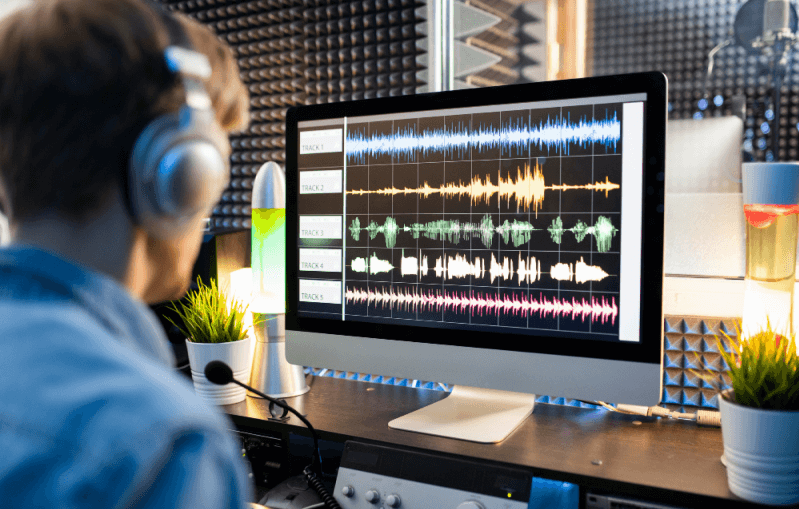A step-by-step handbook to audio visual charlotte nc for business professionals
Recognizing the Inclusion of Audio Visual Modern technology in Today's Educational Environments
The integration of audio-visual modern technology in academic setups has transformed the training and finding out procedure. Educators now have accessibility to devices that accommodate numerous discovering styles, improving student involvement and partnership. The consolidation of these modern technologies presents both opportunities and challenges. Understanding exactly how to effectively apply these tools is crucial. What strategies can instructors use to maximize the advantages of audio-visual modern technology in their class?
The Development of Audio-Visual Technology in Education And Learning
As academic demands progressed over the decades, audio-visual modern technology undertook considerable improvements that reshaped the discovering atmosphere. At first, devices such as movie projectors and slide shows were the main methods of integrating visual components into classrooms. These very early modern technologies provided educators with the capability to existing details dynamically, yet they were restricted in ease of access and interactivity.
With the arrival of videotape recorder in the 1970s, class started to integrate taped lessons, widening the extent of educational resources. The introduction of individual computers in the 1980s further reinvented this landscape, permitting the creation of multimedia discussions and interactive knowing experiences.
The increase of the internet in the 1990s marked a turning point, enabling real-time access to a wide range of audio-visual materials. Today, digital tools such as interactive white boards and on the internet learning systems continue to boost the instructional experience, cultivating involvement and collaboration amongst learners.
Advantages of Audio-Visual Tools for Diverse Knowing Styles
Audio-visual devices play a necessary role in satisfying varied discovering designs by improving aesthetic understanding and improving auditory interaction. By including images, video clips, and sound, these innovations produce an even more inclusive educational atmosphere. This diverse technique enables educators to attend to the diverse preferences and requirements of pupils effectively.
Enhancing Visual Discovering
Engagement in the learning process is significantly enhanced through making use of audio-visual devices, catering to numerous discovering designs. These devices, such as video clips, infographics, and interactive presentations, offer aesthetic stimuli that assist comprehension and retention. Aesthetic students, particularly, gain from the unification of photos and animations, which can simplify complex principles and improve understanding. Additionally, audio-visual resources can show real-world applications, making discovering more relevant and appealing. By incorporating color, motion, and sound, instructors can create a vibrant discovering setting that catches pupils' interest and promotes much deeper cognitive connections. Eventually, the critical use audio-visual modern technology not just sustains aesthetic discovering but likewise enhances the general academic experience for varied students.
Improving Auditory Involvement
A significant advantage of incorporating audio-visual devices in education is their ability to improve auditory engagement among students. These devices, which include multimedia discussions, podcasts, and interactive sound components, satisfy numerous learning designs, specifically profiting acoustic students (audio visual charlotte nc). By integrating noise and narration, educators can develop immersive experiences that record students' interest and reinforce comprehension. This involvement is vital, as it promotes a much deeper understanding of the product and promotes retention. Additionally, audio-visual tools can promote collective learning environments, urging pupils to join conversations and share their insights. Eventually, the consolidation of audio-visual innovation not only sustains auditory interaction but additionally enriches the general instructional experience, making learning much more dynamic and efficient for all pupils
Enhancing Engagement Through Interactive Knowing

Additionally, gamification aspects, such as tests and simulations, can improve inspiration and retention, making discovering more satisfying and efficient. These techniques not only stimulate cognitive interaction yet additionally provide to varied learning styles, guaranteeing that all students can get involved meaningfully. Therefore, interactive knowing environments cultivate a sense of community and belonging, eventually bring about improved academic end results. With the assimilation of audio visual innovation, instructors can change typical class into dynamic rooms where trainees prosper and actively form their academic trips.
Bridging Theory and Technique With Multimedia Resources
Multimedia resources act as a vital web link in between academic ideas and useful application in educational setups. By improving interaction, assisting in collaborative learning experiences, and supporting diverse knowing designs, these devices create a more comprehensive and dynamic understanding atmosphere - audio read more visual charlotte nc. This technique not just promotes much deeper understanding but likewise prepares pupils for real-world difficulties

Enhancing Interaction Through Multimedia
Involvement in educational settings substantially enhances when teachers incorporate multimedia sources right into their training approaches. The usage of video clips, podcasts, and interactive presentations improves the learning experience, permitting pupils to get in touch with the product on several levels. Multimedia resources satisfy numerous finding out designs, giving aesthetic, auditory, and kinesthetic stimuli that can hold students' focus more efficiently than conventional lecture approaches. Furthermore, these sources can streamline intricate concepts, making them much more easily accessible and remarkable. By incorporating multimedia, teachers can create a vibrant class setting that cultivates interest and encourages students. Inevitably, the calculated use audio-visual innovation offers to connect the void in between theoretical understanding and practical application, enriching the educational experience for both teachers and trainees.
Promoting Collaborative Understanding Experiences
Many studies show that collaborative discovering experiences markedly enhance student outcomes when incorporated with multimedia sources. Multimedia tools promote communication among trainees, enabling them to participate in analytical and critical assuming collectively. By utilizing video conferencing, collective systems, and interactive presentations, instructors produce settings for synergy and shared discovering. These modern technologies enable students to communicate their ideas successfully and obtain prompt feedback, promoting a deeper understanding of the topic. Additionally, multimedia sources can present complex principles in more absorbable layouts, promoting discussion and cooperation. Therefore, the combination of collaborative knowing and audio-visual innovation not just enhances the educational experience however additionally prepares pupils for real-world synergy dynamics, highlighting the importance of collaboration and collective knowledge building and construction.
Supporting Diverse Knowing Styles
While standard teaching methods typically provide to a restricted variety of finding out choices, the combination of audio-visual modern technology supplies a much more comprehensive strategy to education and learning. By using multimedia sources such as video clips, interactive simulations, and digital presentations, teachers can deal with different discovering styles, consisting of aesthetic, acoustic, and kinesthetic. This flexibility permits set apart guideline, allowing trainees to engage with content in ways that reverberate with their individual preferences. Additionally, audio-visual devices can assist in much deeper understanding by supplying multiple representations of complicated principles. Consequently, students that may fight with conventional approaches can locate alternative paths to success, cultivating a more equitable learning atmosphere that supports scholastic success for all students.
Challenges in Applying Audio-Visual Modern Technology
Although audio-visual technology holds excellent promise for boosting educational experiences, its application commonly comes across considerable obstacles. One main problem is the economic concern connected with getting and preserving such equipment, which can stress budget plans, especially in underfunded establishments. Additionally, inadequate training for educators can prevent reliable integration, leaving them ill-prepared to use the technology totally. Technical concerns, such as software program breakdowns and compatibility problems, may additionally interrupt lessons and discourage both instructors and trainees. Varying degrees of trainee accessibility to modern technology outside the class can develop differences in discovering opportunities. The capacity for over-reliance on modern technology may take away from necessary training methods, inevitably restricting the educational experience. Attending to these challenges requires a detailed method, consisting of adequate financing, expert growth, and fair access to sources, to ensure that audio-visual technology can be leveraged efficiently in today's academic settings.
Finest Practices for Integrating Technology in the Classroom

In addition, cultivating an interactive environment via collaborative devices urges student engagement and involvement. Making use of diverse audio-visual resources accommodates different learning styles, suiting visual, acoustic, and kinesthetic learners. Regularly evaluating the influence of innovation on trainee discovering assists teachers fine-tune their techniques and adapt to altering needs. Lastly, entailing trainees in the choice of modern technology promotes ownership and motivation. By sticking to these best practices, educators can create a dynamic class atmosphere that properly integrates technology and enhances the educational experience for all students.
The Future of Audio-Visual Innovation in Education And Learning
As classrooms progressively embrace modern technology, the landscape of audio-visual devices in education proceeds to develop (audio visual charlotte nc). Future innovations are expected to concentrate on greater interactivity and personalization, enabling educators to tailor learning experiences to individual pupil demands. Innovations such as increased fact (AR) and virtual truth (VIRTUAL REALITY) will likely supply immersive understanding environments, improving student engagement and understanding
Additionally, expert system (AI) is poised to play a considerable duty in audio-visual technology by using real-time feedback and adaptive learning pathways. This integration may help educators recognize and resolve trainee challenges more effectively. Cloud-based systems will promote easier access to resources and cooperation amongst pupils and educators, no matter area.
Along with these technical developments, professional growth for teachers will be crucial, guaranteeing they are furnished to utilize these devices effectively. In general, the future of audio-visual modern technology in education and learning assures to create more dynamic, comprehensive, and impactful learning experiences.
Frequently Asked Concerns
Just How Can Educators Select the Right Audio-Visual Tools for Their Class?
Selecting suitable audio-visual devices requires educators to analyze their instructional objectives, take into consideration student demands, evaluate available innovation, and seek recommendations from peers or experts, making certain devices efficiently enhance understanding and involvement within their details classroom environment.
What Budget plan Factors to consider Are There for Applying Audio-Visual Innovation?
Spending plan considerations for implementing audio-visual modern technology consist of first acquisition costs, maintenance costs, training for staff, and possible software program licensing costs. In addition, lasting investment in updates and replacements need to also be factored into financial planning.
Exist Details Training Resources for Educators on Audio-Visual Equipment?
Several institutions offer training resources for teachers on audio-visual tools, including online programs, workshops, and educational guides. These resources intend to boost teachers' abilities and self-confidence in successfully integrating technology right into their mentor techniques.
Exactly how Do We Gauge the Effectiveness of Audio-Visual Innovation in Understanding?
Measuring the performance of audio-visual technology in learning involves examining pupil engagement, understanding, retention prices, and overall academic efficiency. Surveys, analyses, and observational studies can provide beneficial insights into its influence on educational outcomes.
What Are Common Mistaken Beliefs Concerning Audio-Visual Modern Technology in Education And Learning?
Usual misconceptions regarding audio-visual technology in education and learning consist of the belief that it guarantees involvement and finding out results, along with the presumption that all trainees benefit equally, neglecting specific understanding choices and needs.